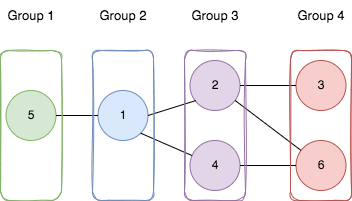Description
You are given a positive integer n representing the number of nodes in an undirected graph. The nodes are labeled from 1 to n.
You are also given a 2D integer array edges, where edges[i] = [ai, bi] indicates that there is a bidirectional edge between nodes ai and bi. Notice that the given graph may be disconnected.
Divide the nodes of the graph into m groups (1-indexed) such that:
- Each node in the graph belongs to exactly one group.
- For every pair of nodes in the graph that are connected by an edge
[ai, bi], ifaibelongs to the group with indexx, andbibelongs to the group with indexy, then|y - x| = 1.
Return the maximum number of groups (i.e., maximum m) into which you can divide the nodes. Return -1 if it is impossible to group the nodes with the given conditions.
Example 1:

Input: n = 6, edges = [[1,2],[1,4],[1,5],[2,6],[2,3],[4,6]] Output: 4 Explanation: As shown in the image we: - Add node 5 to the first group. - Add node 1 to the second group. - Add nodes 2 and 4 to the third group. - Add nodes 3 and 6 to the fourth group. We can see that every edge is satisfied. It can be shown that that if we create a fifth group and move any node from the third or fourth group to it, at least on of the edges will not be satisfied.
Example 2:
Input: n = 3, edges = [[1,2],[2,3],[3,1]] Output: -1 Explanation: If we add node 1 to the first group, node 2 to the second group, and node 3 to the third group to satisfy the first two edges, we can see that the third edge will not be satisfied. It can be shown that no grouping is possible.
Constraints:
1 <= n <= 5001 <= edges.length <= 104edges[i].length == 21 <= ai, bi <= nai != bi- There is at most one edge between any pair of vertices.
Solution
Python3
def is_bipartite(graph, n):
color = defaultdict(int)
def go(x):
for node in graph[x]:
if node not in color:
color[node] = -color[x]
if not go(node):
return False
else:
if color[x] == color[node]:
return False
return True
for i in range(n):
if i not in color:
color[i] = 1
if not go(i):
return False
return True
class Solution:
def magnificentSets(self, N: int, edges: List[List[int]]) -> int:
graph = defaultdict(list)
for a, b in edges:
a -= 1
b -= 1
graph[a].append(b)
graph[b].append(a)
if not is_bipartite(graph, N): return -1
groups = []
grouped = set()
for node in range(N):
if node in grouped: continue
group = set([node])
stack = [node]
while stack:
curr = stack.pop()
for nei in graph[curr]:
if nei in group: continue
group.add(nei)
stack.append(nei)
groups.append(group)
grouped |= group
res = 0
for group in groups:
maxDepth = 0
for start in group:
depth = {}
depth[start] = 0
queue = deque([start])
while queue:
node = queue.popleft()
for nei in graph[node]:
if nei in depth: continue
depth[nei] = depth[node] + 1
queue.append(nei)
maxDepth = max(maxDepth, max(depth.values()))
res += maxDepth + 1
return res